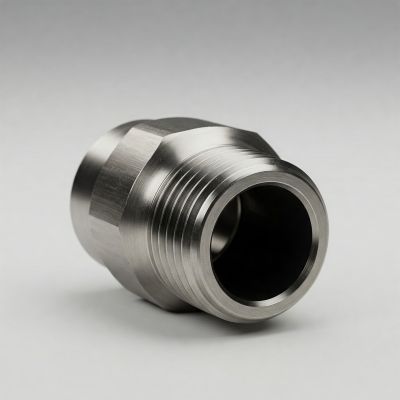Fittings play a crucial role in various applications, including plumbing, automotive, and industrial systems. They ensure secure and leak-proof connections in fluid and gas transfer systems. Among the many fitting types available, inverted flare fittings are widely used due to their reliability and durability.
Inverted flare fittings are known for their strong, leak-resistant seals, making them a preferred choice in high-pressure environments such as hydraulic systems and fuel lines. This article will compare inverted flare fittings with other common fitting types to help you understand their unique advantages and determine the best option for your needs.
What Are Inverted Flare Fittings?
Inverted flare fittings consist of a nut and a flared tubing end that fits securely into a precisely machined flare seat. When tightened, the flare creates a metal-to-metal seal, ensuring a strong and leak-free connection.
How They Create a Secure, Leak-Resistant Connection
Unlike compression or threaded fittings, inverted flare fittings use a mechanical seal formed by the flared tubing end and the fitting seat. This seal is highly resistant to vibration and pressure fluctuations, making it ideal for demanding applications.
Common Materials Used
➡️ Brass (most common for automotive and plumbing applications)
➡️ Stainless steel (used for high-pressure and corrosive environments)
Typical Applications
➡️ Hydraulic systems
➡️ Fuel lines in automotive and aerospace applications
➡️ Brake systems
➡️ Refrigeration and HVAC systems
Common Types of Fittings and Their Characteristics
Compression Fittings
Compression fittings consist of a nut, a compression ring (ferrule), and a fitting body. As the nut is tightened, the ferrule compresses against the tubing, forming a seal.
Common Applications and Advantages:
➡️ Used in plumbing and hydraulic applications
➡️ Easy to install without special tools
➡️ Effective for moderate-pressure systems
Comparison to Inverted Flare Fittings:
➡️ Compression fittings are more prone to leaks under high vibration conditions
➡️ Less effective in high-pressure applications compared to inverted flare fittings
Flare Fittings
Standard Flare vs. Inverted Flare Fittings:
Standard flare fittings require a single flare on the tubing end, while inverted flare fittings have a recessed seat for a stronger seal.
Differences in Sealing Mechanisms:
Both use a flared tubing end, but inverted flare fittings provide better resistance to loosening under vibration.
Performance in High-Pressure Applications:
Inverted flare fittings offer superior performance in hydraulic and automotive brake systems.
Pipe Thread (NPT) Fittings
Threaded Connection Mechanism:
Uses tapered threads to create a seal.
Common Applications and Sealing Challenges:
➡️ Used in plumbing and gas systems
➡️ Requires thread sealant to prevent leaks
Comparison in Terms of Installation and Durability:
➡️ More challenging to install correctly
➡️ Less resistant to vibration compared to inverted flare fittings
Push-to-Connect Fittings
Allow for quick connections without tools by pushing the tubing into the fitting.
Best Use Cases and Limitations:
➡️ Ideal for low-pressure pneumatic systems
➡️ Not suitable for high-pressure hydraulic applications
Comparison to Inverted Flare Fittings:
More convenient but less durable in high-pressure environments
Barbed Fittings
Feature ridges that grip the inside of a flexible hose.
Typical Uses and Strengths:
➡️ Common in low-pressure fluid transfer applications
➡️ Easy to install but requires clamps for security
Differences in Pressure Handling:
Less effective in high-pressure applications compared to inverted flare fittings
Key Differences Between Inverted Flare and Other Fittings
Sealing and Leak Prevention
➡️ Inverted flare fittings provide a metal-to-metal seal that resists leaks better than compression and NPT fittings.
➡️ Threaded fittings require additional sealing materials, increasing the risk of leaks.
Pressure Handling Capability
➡️ Inverted flare fittings are designed for high-pressure applications.
➡️ Compression and push-to-connect fittings are better suited for low to moderate pressure.
Ease of Installation and Maintenance
➡️ Inverted flare fittings require flaring tools for proper installation.
➡️ Push-to-connect and compression fittings are easier to install but may not offer the same durability.
Durability and Longevity
➡️ Made from brass or stainless steel, inverted flare fittings offer excellent longevity.
➡️ Threaded fittings are prone to corrosion and wear over time.
Cost Considerations
➡️ Inverted flare fittings may have a higher upfront cost but provide long-term reliability.
➡️ Compression and push-to-connect fittings are cost-effective for low-pressure applications.
When to Choose Inverted Flare Fittings Over Others
Best Scenarios for Using Inverted Flare Fittings
➡️ High-pressure hydraulic and fuel systems
➡️ Applications where vibration resistance is critical
➡️ Environments requiring leak-proof, long-lasting connections
Industry Examples Where Inverted Flare Fittings Excel
➡️ Automotive brake and fuel systems
➡️ Aerospace hydraulic lines
➡️ Refrigeration and HVAC applications
Cases Where Other Fittings Might Be a Better Choice
➡️ For quick installation and low-pressure applications, push-to-connect fittings are more convenient.
➡️ In plumbing applications, compression fittings may be sufficient.
Conclusion
Inverted flare fittings offer superior leak prevention, durability, and high-pressure performance compared to other fitting types. While they may require specialized tools for installation, their long-term reliability makes them an excellent choice for demanding applications.
When selecting fittings, consider factors such as pressure requirements, vibration resistance, and ease of maintenance. Whether you’re working on a hydraulic system, fuel line, or brake system, choosing the right fitting ensures efficiency and safety.
Need high-quality fittings for your next project? Explore our range of inverted flare fittings to find the perfect solution for your needs!
Post time: Mar-27-2025


